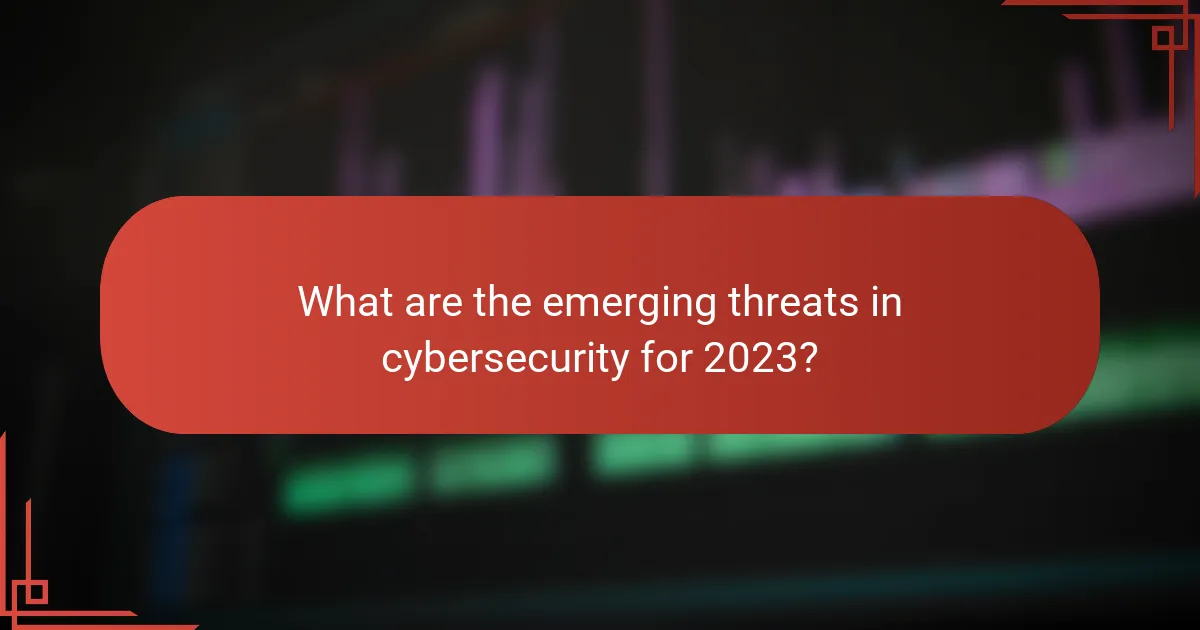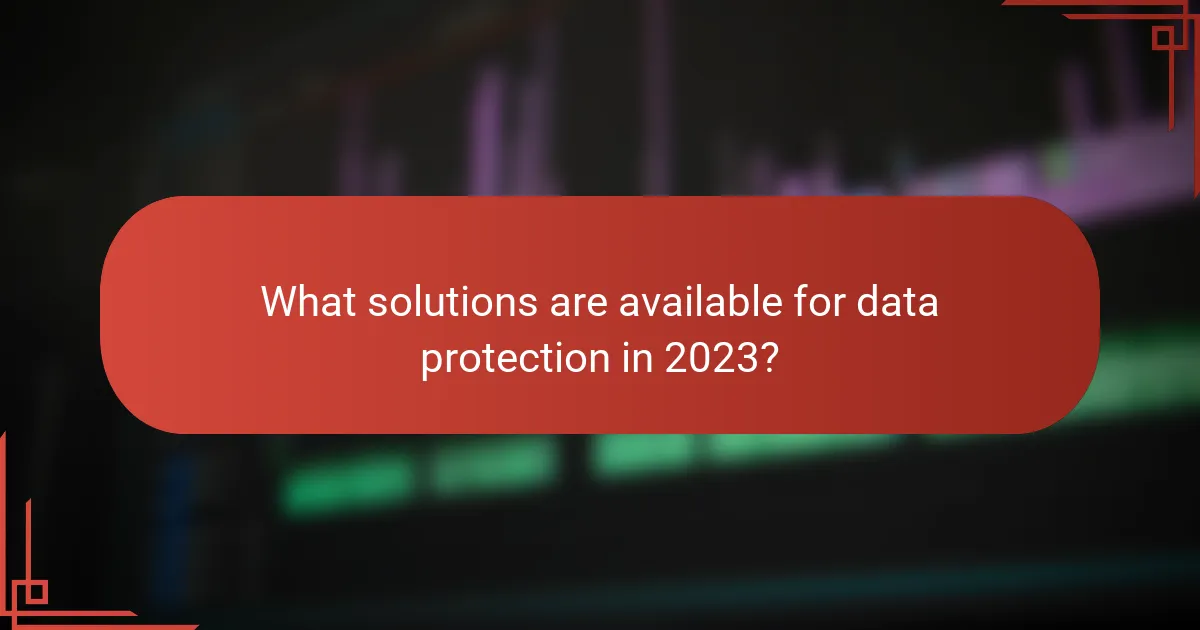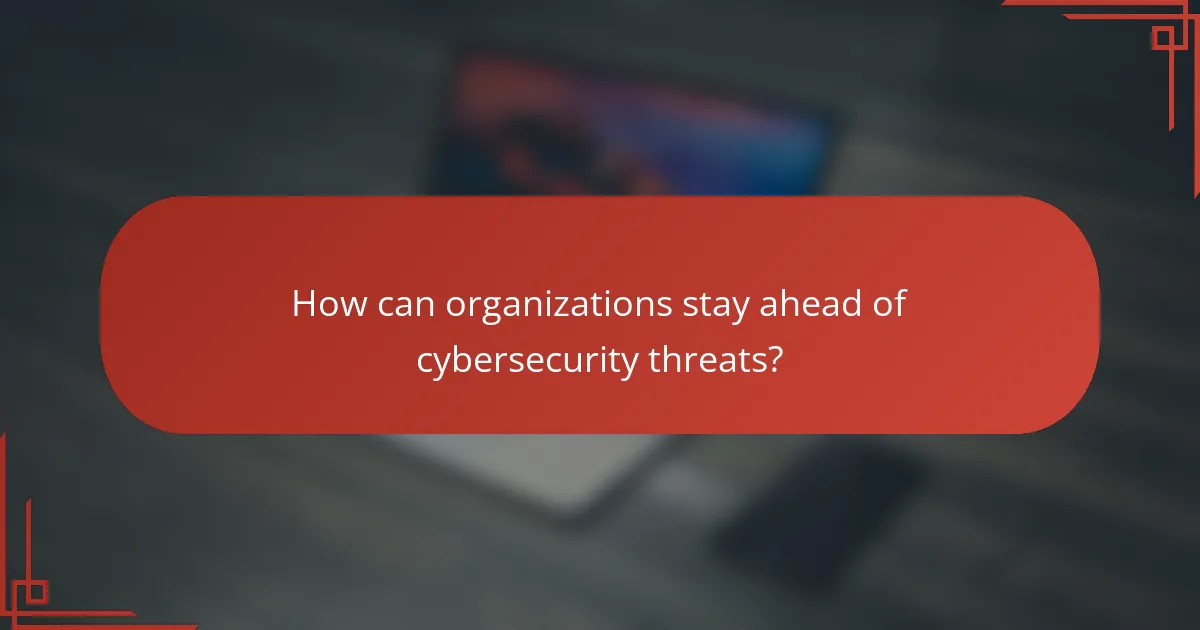Cybersecurity in 2023 is characterized by emerging threats such as ransomware attacks, supply chain vulnerabilities, and AI-driven cyber threats. Ransomware incidents are becoming more sophisticated, with predictions of damages exceeding $30 billion this year. Supply chain vulnerabilities are highlighted by cases like the SolarWinds attack, while AI-driven threats are increasing, affecting over 50% of organizations. To combat these challenges, data protection solutions include advanced encryption, multi-factor authentication, and data loss prevention tools. Proactive security measures, such as regular software updates, employee training, and incident response planning, are essential for organizations to mitigate risks and safeguard sensitive information effectively.

What are the emerging threats in cybersecurity for 2023?
Emerging threats in cybersecurity for 2023 include ransomware attacks, supply chain vulnerabilities, and AI-driven cyber threats. Ransomware attacks have increased in sophistication, targeting critical infrastructure. A report from Cybersecurity Ventures predicts ransomware damages will exceed $30 billion in 2023. Supply chain vulnerabilities have become more pronounced, with attackers exploiting third-party software to gain access. The SolarWinds incident in 2020 exemplifies the risks associated with supply chain attacks. AI-driven cyber threats are on the rise, as hackers use machine learning to automate attacks and evade detection. According to a report by McKinsey, over 50% of organizations have experienced AI-related cyber incidents in the past year. These trends highlight the evolving landscape of cybersecurity threats in 2023.
How do these threats impact data protection?
Emerging threats significantly compromise data protection. Cyberattacks such as ransomware can encrypt or delete critical data. Phishing attempts often lead to unauthorized access to sensitive information. Data breaches expose personal and financial data, leading to identity theft. Malware can disrupt systems and degrade data integrity. Each of these threats increases the risk of non-compliance with data protection regulations. Organizations face financial penalties and reputational damage due to inadequate data security. Overall, these threats create a pressing need for enhanced cybersecurity measures.
What types of cyberattacks are on the rise?
Ransomware attacks are on the rise in 2023. These attacks involve encrypting a victim’s data and demanding payment for decryption. According to a report by Cybersecurity Ventures, ransomware damage costs are projected to reach $265 billion by 2031. Phishing attacks are also increasing, with attackers using deceptive emails to steal sensitive information. The Anti-Phishing Working Group reported a 22% increase in phishing attacks from 2020 to 2021. Additionally, Distributed Denial of Service (DDoS) attacks are becoming more frequent, overwhelming systems with traffic. The frequency of DDoS attacks increased by 15% in the past year, as reported by Cloudflare. These trends indicate a growing threat landscape for organizations worldwide.
How do emerging technologies contribute to these threats?
Emerging technologies contribute to cybersecurity threats by creating new vulnerabilities. For instance, the Internet of Things (IoT) expands the attack surface with numerous connected devices. Each device can be exploited if not properly secured. Artificial Intelligence (AI) can also be misused for sophisticated phishing attacks. AI tools can generate realistic fake communications that deceive users. Additionally, blockchain technology, while secure, can be exploited through smart contract vulnerabilities. According to a 2023 report by Cybersecurity Ventures, cybercrime is projected to cost the world $10.5 trillion annually by 2025, highlighting the urgency of addressing these emerging threats.
Why is understanding these threats crucial for organizations?
Understanding cybersecurity threats is crucial for organizations to protect their sensitive data. Organizations face increasing risks from cyberattacks, which can lead to data breaches and financial loss. According to a report by Cybersecurity Ventures, global cybercrime damages are expected to reach $10.5 trillion annually by 2025. Awareness of these threats enables organizations to implement effective security measures. This proactive approach reduces vulnerabilities and enhances incident response capabilities. Additionally, understanding threats fosters a culture of security awareness among employees. This can significantly lower the likelihood of human error, which is a common factor in security breaches. Overall, comprehending these threats is essential for safeguarding organizational integrity and maintaining customer trust.
What are the potential consequences of data breaches?
Data breaches can lead to severe consequences for individuals and organizations. They often result in financial losses due to fraud or theft. According to the IBM Cost of a Data Breach Report 2023, the average cost of a data breach is $4.45 million. Affected individuals may face identity theft, which can damage credit ratings. Organizations may suffer reputational damage, leading to loss of customer trust. Legal consequences can arise from non-compliance with data protection regulations. Companies may incur regulatory fines, further impacting their finances. Additionally, data breaches can disrupt business operations, leading to decreased productivity. These consequences highlight the critical need for robust cybersecurity measures.
How can organizations assess their vulnerability to these threats?
Organizations can assess their vulnerability to cybersecurity threats by conducting regular risk assessments. This process involves identifying critical assets and potential threats. Organizations should evaluate existing security measures and their effectiveness. They can perform [censured] testing to simulate attacks and uncover weaknesses. Additionally, employee training on cybersecurity awareness is crucial. Monitoring network traffic can help detect unusual activities. Utilizing vulnerability scanning tools provides insights into system weaknesses. Finally, organizations should review compliance with industry regulations to ensure standards are met. These methods collectively enhance an organization’s understanding of its vulnerability landscape.

What solutions are available for data protection in 2023?
Data protection solutions in 2023 include advanced encryption, multi-factor authentication, and data loss prevention tools. Encryption secures data at rest and in transit, making unauthorized access difficult. Multi-factor authentication adds an extra layer of security by requiring multiple verification methods. Data loss prevention tools monitor and control data transfers to prevent leaks. Cloud security solutions protect data stored in cloud environments. Endpoint security software safeguards devices against malware and unauthorized access. Regular security audits and compliance checks ensure adherence to regulations. Implementing these solutions helps organizations mitigate risks and protect sensitive information effectively.
How can organizations implement effective cybersecurity measures?
Organizations can implement effective cybersecurity measures by adopting a multi-layered security approach. This approach includes using firewalls to block unauthorized access. Regular software updates are essential to patch vulnerabilities. Employee training on phishing and social engineering is crucial for awareness. Implementing strong password policies enhances account security. Organizations should also conduct regular security audits to identify weaknesses. Data encryption protects sensitive information from unauthorized access. Lastly, incident response plans prepare organizations for potential breaches. According to a 2022 report by Cybersecurity & Infrastructure Security Agency, organizations with comprehensive security strategies reduce breaches by up to 70%.
What role do firewalls and antivirus software play?
Firewalls and antivirus software play critical roles in cybersecurity. Firewalls act as barriers between trusted internal networks and untrusted external networks. They monitor incoming and outgoing traffic based on security rules. This helps prevent unauthorized access and attacks. Antivirus software detects, prevents, and removes malicious software from devices. It scans files and programs for known threats and suspicious activity. According to the Cybersecurity & Infrastructure Security Agency (CISA), using both tools significantly enhances protection against cyber threats. Together, they form a comprehensive defense strategy against data breaches and malware attacks.
How can employee training enhance cybersecurity?
Employee training enhances cybersecurity by improving awareness of threats and safe practices. Educated employees are more likely to recognize phishing attempts and suspicious activities. A study by the Ponemon Institute found that organizations with regular cybersecurity training experienced 50% fewer breaches. Training also fosters a culture of security within the organization. Employees become proactive in reporting potential vulnerabilities. This collective vigilance significantly reduces the risk of data breaches. Continuous training helps keep staff updated on evolving threats. Thus, investing in employee training is essential for robust cybersecurity.
What are the best practices for data protection?
Implementing strong data protection practices is essential for safeguarding sensitive information. Use encryption to protect data at rest and in transit. Regularly update software and systems to patch vulnerabilities. Employ strong, unique passwords and enable multi-factor authentication for access control. Conduct regular security audits to identify and mitigate risks. Train employees on data protection policies and phishing awareness. Backup data frequently and store backups securely. Monitor networks for unusual activity to detect potential breaches. These practices help reduce the risk of data breaches and ensure compliance with regulations.
How can encryption safeguard sensitive information?
Encryption safeguards sensitive information by converting it into a coded format. This process ensures that only authorized users can access the original data. When data is encrypted, it becomes unreadable to anyone without the decryption key. This significantly reduces the risk of unauthorized access during data transmission or storage. According to a report by the Ponemon Institute, 60% of organizations experienced a data breach in the past year, highlighting the importance of encryption as a protective measure. Furthermore, encryption is mandated by regulations such as GDPR and HIPAA for protecting personal and health information. By using strong encryption algorithms, organizations can enhance their data security and maintain user trust.
What strategies can be employed for incident response?
Effective incident response strategies include preparation, detection, analysis, containment, eradication, recovery, and post-incident review. Preparation involves creating incident response plans and training teams. Detection focuses on identifying potential security incidents through monitoring systems. Analysis requires assessing the nature and scope of the incident to understand its impact. Containment aims to limit the damage by isolating affected systems. Eradication involves removing the cause of the incident from the environment. Recovery focuses on restoring and validating system functionality. Post-incident review is essential for learning and improving future response efforts. According to the 2023 Verizon Data Breach Investigations Report, organizations with a structured incident response plan can reduce the impact of security incidents significantly.

How can organizations stay ahead of cybersecurity threats?
Organizations can stay ahead of cybersecurity threats by implementing proactive security measures. Regularly updating software and systems helps close vulnerabilities. Conducting frequent security audits identifies potential weaknesses. Employee training on cybersecurity best practices reduces human error. Utilizing advanced threat detection tools enhances response capabilities. Establishing an incident response plan ensures preparedness for breaches. Collaborating with cybersecurity experts provides access to the latest intelligence. According to a 2022 report by Cybersecurity Ventures, organizations that invest in these measures can reduce breach costs by up to 50%.
What tools and technologies are essential for proactive defense?
Essential tools and technologies for proactive defense include firewalls, intrusion detection systems, and endpoint protection platforms. Firewalls act as barriers between trusted and untrusted networks. They monitor incoming and outgoing traffic based on predefined security rules. Intrusion detection systems identify and respond to potential threats in real time. They analyze network traffic for suspicious activity. Endpoint protection platforms secure devices such as computers and mobile phones. They provide antivirus protection and threat detection. Additionally, Security Information and Event Management (SIEM) systems aggregate and analyze security data. They enhance visibility and response capabilities. Threat intelligence platforms provide insights into emerging threats. They help organizations stay ahead of potential attacks.
How can threat intelligence improve security posture?
Threat intelligence can significantly improve security posture by providing organizations with actionable insights. It helps identify potential threats before they materialize. This proactive approach enables timely responses to vulnerabilities. According to a study by the Ponemon Institute, organizations using threat intelligence can reduce the average cost of a data breach by $1.4 million. Furthermore, integrating threat intelligence into security frameworks enhances incident response capabilities. It allows for better prioritization of security measures based on real-time data. This results in a more resilient security infrastructure. Ultimately, threat intelligence fosters a culture of continuous improvement in cybersecurity practices.
What are the benefits of regular security audits?
Regular security audits enhance an organization’s cybersecurity posture. They identify vulnerabilities within systems and processes. This proactive approach mitigates risks before they can be exploited. Regular audits ensure compliance with industry standards and regulations. They help maintain customer trust by safeguarding sensitive information. Additionally, audits can lead to improved incident response strategies. According to a 2023 report by Cybersecurity Ventures, organizations that conduct regular audits reduce the likelihood of data breaches by 30%. Thus, regular security audits are essential for effective cybersecurity management.
What practical steps can organizations take to enhance cybersecurity?
Organizations can enhance cybersecurity by implementing multi-factor authentication (MFA). MFA significantly reduces unauthorized access by requiring multiple verification methods. Regular software updates are essential; they patch vulnerabilities and strengthen defenses. Conducting security awareness training for employees helps identify phishing attacks and other threats.
Establishing a robust incident response plan allows organizations to react swiftly to breaches. Regularly backing up data ensures recovery in case of ransomware attacks. Utilizing firewalls and intrusion detection systems provides an additional layer of protection against cyber threats. Finally, conducting regular security audits identifies weaknesses and areas for improvement.
How often should organizations update their cybersecurity policies?
Organizations should update their cybersecurity policies at least annually. Regular updates ensure that policies reflect the latest threats and compliance requirements. Cybersecurity is an evolving field, with new vulnerabilities emerging frequently. The 2022 Cybersecurity Report by IBM highlights that organizations face increasing cyber threats. This report emphasizes the importance of proactive policy updates. Additionally, organizations should review their policies after significant security incidents. This approach helps to address any gaps identified during such events. Maintaining updated policies reduces the risk of data breaches and enhances overall security posture.
What resources are available for continuous learning in cybersecurity?
Numerous resources are available for continuous learning in cybersecurity. Online courses from platforms like Coursera and edX offer structured learning paths. Websites such as Cybrary provide free and paid training materials. Books on cybersecurity topics are published regularly by experts in the field. Industry certifications, including CompTIA Security+ and Certified Information Systems Security Professional (CISSP), enhance knowledge and credibility. Cybersecurity conferences and webinars allow professionals to stay updated on trends. Community forums and discussion groups foster peer learning and knowledge sharing. Government resources, like the National Institute of Standards and Technology (NIST), provide guidelines and best practices.
The main entity of this article is cybersecurity, specifically focusing on emerging threats and solutions for data protection in 2023. Key threats include sophisticated ransomware attacks, supply chain vulnerabilities, and AI-driven cyber threats, which collectively pose significant risks to data protection and organizational integrity. The article outlines the impact of these threats on data security, potential consequences of data breaches, and the importance of understanding and addressing these challenges. Additionally, it discusses effective cybersecurity measures, tools, and best practices that organizations can implement to enhance their defenses against evolving cyber threats.


